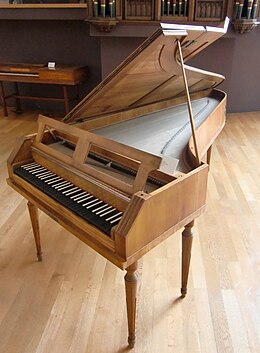| Piano Concerto in C minor | |
|---|---|
| No. 24 | |
| by W. A. Mozart | |
 A fortepiano from the period | |
| Catalogue | K. 491 |
| Style | Classical period |
| Composed | 1786: Vienna |
| Published | 1800 |
| Movements |
|
| Scoring |
|
The Piano Concerto No. 24 in C minor, K. 491, is a concerto composed by Wolfgang Amadeus Mozart for keyboard (usually a piano or fortepiano) and orchestra. Mozart composed the concerto in the winter of 1785–1786, finishing it on 24 March 1786, three weeks after completing his Piano Concerto No. 23 in A major. As he intended to perform the work himself, Mozart did not write out the soloist's part in full. The premiere was in early April 1786 at the Burgtheater in Vienna. Chronologically, the work is the twentieth of Mozart's 23 original piano concertos.
The work is one of only two minor-key piano concertos that Mozart composed, the other being the No. 20 in D minor. None of Mozart's other piano concertos features a larger array of instruments: the work is scored for strings, woodwinds, horns, trumpets and timpani. The first of its three movements, Allegro, is in sonata form and is longer than any opening movement of Mozart's earlier concertos. The second movement, Larghetto, in E♭ major—the relative major of C minor—features a strikingly simple principal theme. The final movement, Allegretto, is a theme and eight variations in C minor.
The work is one of Mozart's most advanced compositions in the concerto genre. Its early admirers included Ludwig van Beethoven and Johannes Brahms. Musicologist Arthur Hutchings declared it to be, taken as a whole, Mozart's greatest piano concerto.